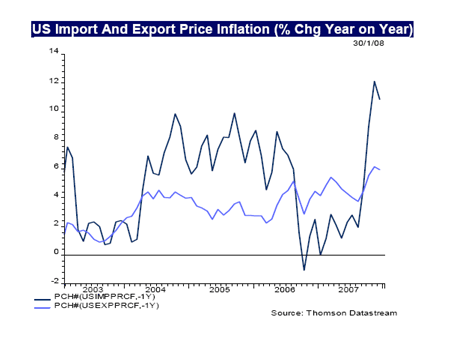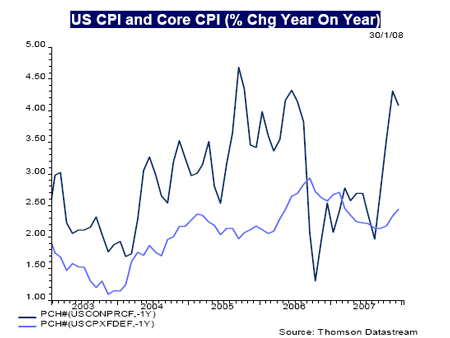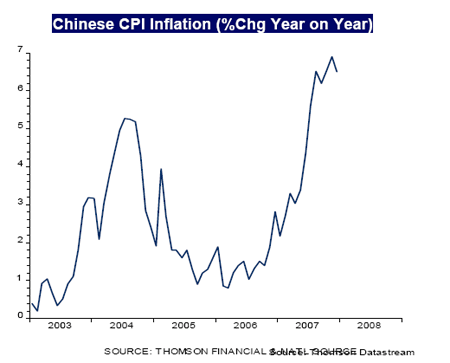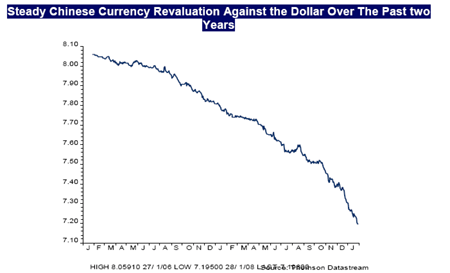How the Fed just made this crisis a whole lot worse
The Fed's rate cuts and $156bn fiscal stimulus package may have reduced the risk of near-term economic downturn, but it has increased the scale of a long-term crisis, says Jeremy Batstone-Carr.
Bond, equity and currency markets have reacted sharply to the Federal Reserve's aggressive decision to cut US base rates, intra-meeting, by 0.75% points and by a further 0.5% points at its scheduled 30th January Open Markets Committee meeting.
The pace of this reduction is unparalleled and takes the US Fed Funds rate down to 3.0%, representing a whole 2.5% point easing from the point at which the US central bank began cutting the key rate on 18th September. Views polarise as to whether the Fed has acted in time, too late, too aggressively or not aggressively enough.
Although our base case is built on the view that the US economy slid into recession in December 2007 (and thus aggregated data for Q4 shows the economy moving ahead, albeit at a much slower pace than that recorded over Q3), sufficient doubt as to whether the US is actually in recession causes us to consider the possibility that we might be wrongand what the most significant implication of that might be.
MoneyWeek
Subscribe to MoneyWeek today and get your first six magazine issues absolutely FREE

Sign up to Money Morning
Don't miss the latest investment and personal finances news, market analysis, plus money-saving tips with our free twice-daily newsletter
Don't miss the latest investment and personal finances news, market analysis, plus money-saving tips with our free twice-daily newsletter
We start with what we know. We know that in the recent past the West has enjoyed an unprecedented (post WW2) period of unbroken prosperity and that the economic (monetary) policy of the past decade has been characterised by the creation of a series of asset price bubbles, particularly in the financial sector and in real estate, the evolution of massive external deficits and the re-ignition of inflationary pressuresfollowed by a collapse!
Whether the latest moves in equity and bond markets reflect nothing more than another mid-cycle correction or the atypical end of the cycle remains to be seen but what we suspect is that if we're wrong and the financial market experience of the past two months turns out to be nothing more than another, very large, mid-cycle correction the Fed will be roundly criticised for misreading the tea leaves and panicking into overly aggressive policy action by fretful markets.
In fact we have been here before and not all that long ago. This year marks the tenth anniversary of the Asian crisis, a period with uncanny similarities and yet also profound differences to today's conditions. Back then the trigger for the Asian crisis proved to be the innate fragility of the emerging Asian economies' primitive financial systems. The recent experience reveals, if anything, the vulnerabilities of an oversophisticated Western financial system. Back then, the response from the Greenspan Fed was to create a period of aggressive disinflation which looked, for a period, as if it might morph into an all-out debt deflationary spiral (Armageddon for financial markets). If recent experience is anything to go by it appears that the Bernanke Fed has opted for the same old medicine in its attempts to stave off the atypical downturn.
One factor that was emerging as an issue ten years ago and has become an issue of profound consequence now is the extent of the debt mountain. Whilst we accept that monetary policy is a blunt instrument when attempting to re-calibrate the economic barometer we do admit to concerns regarding the effectiveness of monetary policy in making any difference when financial sector, non-financial sector and household debt levels have risen, in the USA, to around 90% of GDP. The only domestic US sector with anywhere near sufficient capacity to add to existing levels of debt is the government and if the recent bipartisan agreement between president Bush and the democrats is anything to go by that looks like being another popular route towards the desired economic salvation.
The inference is pretty clear to us. We have reached the point at which the mountain of debt has become unmanageable, indigestion has set in and the authorities are pushing on a string. In this context the crisis in the credit market, whilst clearly needing a near-term solution, is ultimately part of the long-term solution.
By cutting base rates as aggressively as the Federal Reserve has done and by announcing a $156bn fiscal stimulus package which will, eventually, put additional cash in people's pockets and increasing the ability to service debt, the US government and central bank are reducing the risk of a severe near-term economic downturn but are, at the same time, increasing the scale of the long-term crisis.
Inflation rocky too!
We accept that the Federal Reserve's remit is to act as a nominal demand manager rather than an anti-inflation hawk, however, we fear there might be a problem should the Fed chose to ignore prevailing inflationary pressures altogether. The US authorities and to a lesser extent, the Bank of England, appear increasingly convinced that these pressures will ebb as 2008 progresses, activity slows, surplus productive capacity emerges and base effects improve. It is clear to us that any long-term turnaround in the US fortunes beyond the quick fix monetary and fiscal measures in train is likely to depend upon less dependence on debt financed spending and a reduced dependency on imports. Key to this will be the performance of the dollar on the world's foreign exchanges.
Profound structural weaknesses in the US economy underpin our long-held view that the US currency is in prolonged decline. But dollar weakness raises the prospect that inflationary embers, far from cooling, might actually reignite. The charts (below) illustrate the extent to which import and export price inflation are beginning to react to the dollar's devaluation.

If one ignores the core measure of US inflation (excluding food and energy) and focuses on the headline rate of inflation the following chart makes it entirely obvious that inflationary pressures have already reasserted themselves.

Simply by ignoring energy and food prices, one misses out the two single biggest inflationary forces currently affecting the global economy. We make two points. Firstly, that the US economy is not an island cut off from the rest of the world (although some in Congress would have it that way), how could it have become so prosperous if it were?, and that Americans eat and drive vehicles just like the rest of us. Secondly, the strength of both energy and food prices has already engendered a strong reaction from the Peoples Bank of China where concerns regarding an over-heating economy in an Olympic year are a very "live" issue.

The above chart illustrates the fact that Chinese CPI has accelerated to c7% from 2.5% just one year ago. We have highlighted, in the past, the problems associated with a pegged Chinese exchange rate, however, the following chart indicates that in typically cautious fashion, the Chinese are addressing the issue.

The Chinese authorities are well aware of the threat posed by a pegged exchange rate during a period in which the economy is growing at a rapid pace. Even in spite of monetary policy tightening the economy still risks over-heating and without a freefloating currency the country must accept the inevitability of double digit inflation or an entirely avoidable bout of severe domestic demand deflation, the possible consequences of which are hardly something the authorities want to countenance with the eyes of the world on them next August / September! The chart shows that, little by little the renminbi is rising against the dollar.
Whilst we never expected the Chinese to abandon the currency peg at one go, we're beginning to get into the realms in which the debate regarding the resolution of global economic imbalances can begin again. For the purposes of this piece all we'll add for now is that in addition to escalating oil, raw material and food prices one might, in time add rising manufactured goods to the list for Western inflation hawks to worry about.
Conclusion
Is the US economy experiencing an atypical end to an economic cycle or is the current environment little more than an exaggerated mid-cycle correction? If the former, Fed policy is appropriate, if the latter the reaction of the US authorities will be adjudged excessive and panicky.
There's more to this than simply the reputation of Dr Bernanke. Away from the increasingly irrelevant underlying inflation data, inflationary pressures are becoming built-in. Mid-cycle correction or something worse, we view the dollar's ongoing devaluation on the world's foreign exchanges as inevitable (with the dishonourable exception of sterling, which we believe to be in an even worse boat) and particularly so against the Chinese renminbi.
In addition to rising energy, food and basic raw material inflation the risk to our central assumption is that a rising Chinese currency adds the prospect of higher manufactured and semi-manufactured goods prices to the mix, providing Western monetary authorities with something of a headache as they attempt to plot a navigable course between Scylla and Charbydis.
By Jeremy Batstone-Carr, Director of Private Client Research at Charles Stanley
Get the latest financial news, insights and expert analysis from our award-winning MoneyWeek team, to help you understand what really matters when it comes to your finances.
MoneyWeek is written by a team of experienced and award-winning journalists, plus expert columnists. As well as daily digital news and features, MoneyWeek also publishes a weekly magazine, covering investing and personal finance. From share tips, pensions, gold to practical investment tips - we provide a round-up to help you make money and keep it.
-
 Leading European companies offer long-term growth
Leading European companies offer long-term growthOpinion Alexander Darwall, lead portfolio manager, European Opportunities Trust, picks three European companies where he'd put his money
-
 How to harness the power of dividends
How to harness the power of dividendsDividends went out of style in the pandemic. It’s great to see them back, says Rupert Hargreaves

